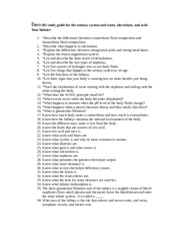Urinary System Study Guide Ch 16
Waste product, produced by the kidneys to eliminate waste and help with electrolyte balance, water balance, and acid-base balance Normally clean enough to drink and has been repurposed for many uses such as: antiseptic, shrink preventative, and used for its potassium nitrate crystals to make explosives Wastes mainly derived from protein metabolism including: urea, uric acid, creatine, and ammonia Gets its yellow color from urobilin, a waste product of hemoglobin metabolism Also contains excess water, acid, and electrolytes 'Liquid gold' -99% water- 1 to 2 L produced a day on average. Long, thin, flexible muscular tubes that connect to the bladder Consists of 3 layers: mucosa, muscularis, and adventitia Embedded in a blanket of retroperitoneal fat and travel in the retroperitoneum on either side of the vertebral column After crossing the posterior brim of the bony pelvis, they turn forward and travel in the bladder wall for short distance before opening into the bladder lumen Ureters then enter bladder floor Actively massage urine downward by peristaltic waves in response to ANS. 'Holding tank' for urine Protected by bony barrier of the symphysis pubis; anterior to rectum in males or vagina in females Peritoneal membrane covers the superior surface of the bladder Composed of 3 layers: inner mucosal layer (contains rugae) of transitional epithelium, middle muscular layer, and an outer adventitia of fibrous tissue Muscular wall of bladder is the detrusor muscle, innervated by autonomic nerve fibers Empty bladder shaped like a collapsed basketball Max capacity for average male is 700 to 800 mL, slightly less in females uterus allows less room for bladder expansion.
Regulates sodium reabsorption and potassium secretion via their action on the renal tubule Increases renal sodium reabsorption by increasing the number of sodium channels and sodium-potassium pumps in cells of the cortical collecting duct Na-K pump transports K on the opposite direction of sodium-therefore, by increasing Na reabsorption, aldosterone also increases K secretion-blood Na rises as blood K falls and vice versa Chief of the mineralocorticoids Increases homeostatically as (a) blood pressure falls or (b) as blood potassium rises. Unique osmotic gradient which generates concentrated urine, dependent on the nephron loops of juxtamedullary nephrons This gradient is the difference in the osmotic pressure between different regions of the renal medulla Deeper medullary regions toward the tips of the nephron loops contain much more solute and have higher osmotic pressure than regions nearer the cortex Nephron loop establishes the medullary osmotic gradient, but it is the collecting duct that uses the gradient to concentrate urine-and orientation of collecting duct is all-important. Much less common than metabolic acidosis Results from the loss of acids.

Such as loss from gastric acid followed by repeated vomiting, or gain of bases-such as ingestion of large amounts of antacids 3 events occur in response: -buffers tend to release their H ions (ex: hemoglobin releases some H ions) -respiration slows in order to retain more CO2, which reacts to produce H+ and bicarbonate -most importantly, the kidney excretes bicarbonate. As result, H+ ions in blood remain unbuffered and pH decreases.
Bio photosynthesis guide answers. Urinary System Chapter Overview This chapter is about the urinary system, which plays a vital role in maintaining the internal environment by excreting nitrogenous waste products and by selectively excreting or retaining water and electrolytes. It identifies, locates, and describes the functions of the organs of the urinary system (objectives 1-3). It explains the structure and function of the nephron-the basic unit of function of the kidney (objective 5). It traces the pathway of blood through the blood vessels of the kidney, explains how glomerular filtrate is produced, and discusses the role of tubular reabsorption in urine production and the cause of change in the osmotic concentration of the glomerular filtrate of the renal tubule (objectives 4 and 6-10). It also describes the role of tubular secretion in urine formation (objective 11). It discusses the structure of the ureters, urinary bladder, and urethra, and how they function in micturition (objectives 12 and 13). A study of the urinary system is basic to understanding how the body maintains its chemistry within very narrow limits.


Anatomy And Physiology Urinary System Study Guide
2002 McGraw-Hill Higher Education Any use is subject to the and. Is one of the many fine businesses of.